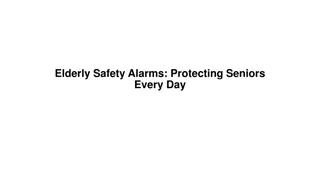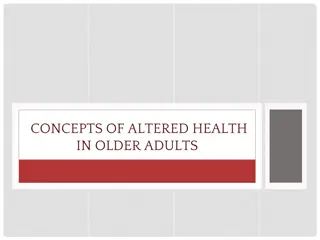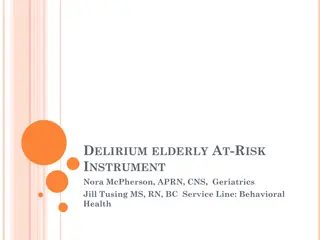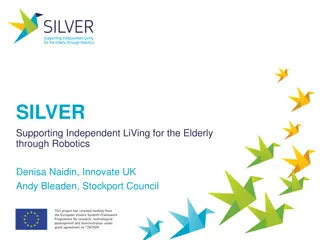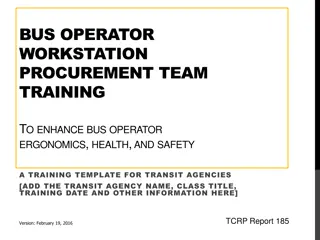Understanding Ergonomics for the Elderly: Adapting to Age-Related Changes
Our bodies and minds undergo changes as we age, necessitating adjustments in our environment to accommodate limitations. The design of everyday products often overlooks the needs of older individuals, leading to difficulties in tasks such as handling objects and sensory impairments. This article discusses the impact of aging on musculoskeletal and neuromuscular systems, as well as changes in the senses like vision and hearing, providing insights on how to address these challenges for the elderly.
Download Presentation

Please find below an Image/Link to download the presentation.
The content on the website is provided AS IS for your information and personal use only. It may not be sold, licensed, or shared on other websites without obtaining consent from the author. Download presentation by click this link. If you encounter any issues during the download, it is possible that the publisher has removed the file from their server.
E N D
Presentation Transcript
ERGONOMICS For the ELDERLY
As we age, our bodies and minds change. So our environment needs to change too. Sadly, older people often have problems using everyday products because the design of many commonly used products do not take into account their limitations. Things that require flexible fingers or strong hands can be almost impossible for some seniors to use. Even if they can manage to open that prescription bottle or replace the batteries in their hearing aid, it can be a time-consuming and frustrating experience. Older people feel forgotten and ignored by the designers and engineers who failed to consider their needs and limitations. They are embarrassed and humiliated when they need help with simple tasks. Aging Ergonomics
Several sections cover the sections on changes to our Aging Bodies: Musculoskeletal (muscles and bones) and Neuromuscular (muscles and nerves) followed by those related to in our Aging Senses: Seeing Hearing Smelling Tasting Touching Our Aging Senses
THE AGING EYE: The pupil shrinks with age. This shrinkage is called senile miosis. By age 60, the pupil is only one-third its size at age 20. This is a disadvantage for older adults in a dim light because their pupils cannot open as much to let in more light. But in bright light, a smaller pupil provides a slight advantage because the smaller pupil is closer to the optimum size for producing a sharp retinal image. Senile miosis may also improve contrast sensitivity, and may help compensate for lens by reducing the scatter of light within the eye. Seeing
THE AGING EAR: The aging ear is more sensitive to noise-induced hearing loss. Older people will experience greater hearing loss than young people, when both are exposed to the same damaging level of noise. All aspects of hearing are affected by age: loudness discrimination, speech discrimination, and frequency. As they get older, both men and women lose hearing at the lowest and the highest frequencies. Hearing
Degree of Hearing Loss Decibel Level Examples Effect Normal Hearing -15 to 10 dB rustling leaves No hearing related problem Difficulty hearing very quiet speech, especially in noisy places Borderline Normal 11 to 25 dB faint speech Difficulty hearing faint or distant speech even in a quiet place May not hear verbal warnings of danger whispers, quiet talking Mild Hearing Loss 25 to 40 dB Can hear nearby conversations May not hear distant warning signals, especially in noisy places Cannot hear distant voices Can hear only loud close conversations Cannot hear distant car horns, warning signals, or voices in noisy places Cannot hear normal conversational speech May hear close loud voices Cannot hear car horns, warning signals or voices May hear loud sounds Hearing is no longer a primary form of communication Cannot hear car horns, warning signals or voices quiet or normal speech, radio at normal volume Moderate Hearing Loss 40 to 55 dB normal or loud speech, doorbell Moderately Severe Hearing Loss 55 to 70 dB telephone rings, thunder Severe Hearing Loss 70 to 90 dB power tools, chain saw Profound Hearing Loss 90 dB or more examples of different levels of hearing loss and the effects
The smell receptors are extremely sensitive, but they tire easily. That is why we no longer notice an odor after a few minutes of exposure. Our smell receptors no longer respond to that odor. The technical term for this is olfactory fatigue. Our noses get tired of smelling the same old stuff and turn off (i.e. stop responding to the smell) while they wait for something more interesting to come along. We cannot detect smells very well if we have a stuffy nose or have allergies such as hay fever. Inflammation in the nasal tissue or the thicker mucous coating that covers the epithelium can prevent odorants from reaching the smell receptors. A poor sense of smell can also affect how foods taste because of the close relationship between smell and taste. Our tongues and noses work together. While the tongue can detect only 5 distinct flavors, the nose can detect hundreds of scents. Together, taste and smell produce our sensation of flavor. Smelling
Our taste buds don't last very long. On average, they live only 7-10 days before they die off and are replaced by new receptors. As we age, this replacement process slows down. More taste receptors are lost than are replaced, causing a gradual loss the sense of taste going from middle age to old age. Other factors such as illnesses and use of drugs, excessive exposure to X-rays, smoking, and excess alcohol consumption can also slow down the replacement process of taste receptors. This is why smokers and heavy drinkers have a poorer sense of taste and require heavier seasoning of foods, to compensate for the loss of taste buds.. Between the ages of 50 and 70, taste preferences generally shift away from sweet flavors towards tart ones. Cultural factors, traditions and taboos also play an important role in shaping taste preferences. Tasting
Free nerve endings respond equally to all sorts of stimuli: chemicals, pressure, temperature extremes, tissue damage, electric current, radiant energy, unlike the encapsulated end organs (Meissner, Pacinian, etc.) which respond to specific stimuli. Free nerve endings also respond to the other types of touch, but with less precision than the encapsulated end organs. The periphery of the body has the greatest sensitivity to touch, with sensitivity decreasing as one moves from peripheral areas to areas in the midline of the body. Our fingertips are highly sensitive and have very good touch discrimination, whereas the skin over our stomach is relatively insensitive and unable to distinguish light stimuli. Touching
Getting people to accept changes, even ones that are ergonomically correct, is difficult. People resist change. That's just human nature. They're especially resistant to change if it is imposed upon them. They resent feeling powerless and passive, of having no say in the matter. The Soft Side of Ergonomics
People will not be dazzled into agreement and acceptance by a tour-de-force display of ergonomic knowhow. They need to be won over with gentle persuasion. Older adults have their pride; they do not want to be bossed around as if they were children. They have their settled habits and it will greatly undermine their sense of familiarity to have their routines and habits re-arranged, especially when they feel it is unnecessary. Creating a senior-friendly ergonomic home must be done with them, not to them. Discuss the changes that you are thinking about and get their feedback. Do not belittle their concerns or pooh-pooh their fears -- their concerns are legitimate and should be treated with respect, even if you do not agree with them. Try to see their point of view and they may be more willing to see yours R-E-S-P-E-C-T
Go easy with the older folks. They have lived long lives and have been productive in their own time, in their own way, in their own world. They developed survival skills for the hardships and challenges that they have faced and conquered. Though their skills and perspectives may no longer seem relevant in today's environment, respect them. Be respectful of their perspectives, their opinions, and their preferences. This may require a good dose of patience, which sounds easy, but can be hard, especially if you are hard pressed by the demands of your own life. Older people sometimes stubbornly refuse to admit that they need help or that a change would be good. It is hard for them to think of themselves as old; they do not want to admit their deficits for fear of being marginalized. Seniors prize their independence, even when they can no longer be independent.
Introduce new ideas slowly and don't overwhelm them with too many choices at one time. Get feedback from them on the proposed changes -- ask them how they would feel about it, whether they would be willing to give it a try. For instance, ask them to try out a bathtub grab bar or a shower seat. If they refuse, find out why. Older people do not want to be stigmatized as old people (even if they are old). A walker or cane is tangible evidence of a deficit -- one which they may not be willing to accept. They may think of their weakness as a temporary setback, rather than a sign of a permanent, irreversible decline. Don't try to get them to accept the inevitably of their aging -- they will resist. Instead, agree that "perhaps this is just a temporary setback or condition, but for the meantime, to give everyone a little peace of mind, please consider using this aid." Easy Does It
Mention that you worry about them and would feel more at ease in your mind knowing that they have this aid or device that they can use if they choose. They may be (gently) persuaded if they think it will help you. Let them know that you're not going to force a change upon them (unless it is truly a matter of life or death). Let them know that you want them to try something new, in hopes that it will make life easier for them and allow them to continue living independently. By proposing the change as a trial, they will be reassured that they can refuse it and have it taken away if it does not suit them. This gives them a sense of control over the situation, which may make them more amenable to your suggestions.
Contoh Permasalahan MANULA di rumah secara Ergonomis






